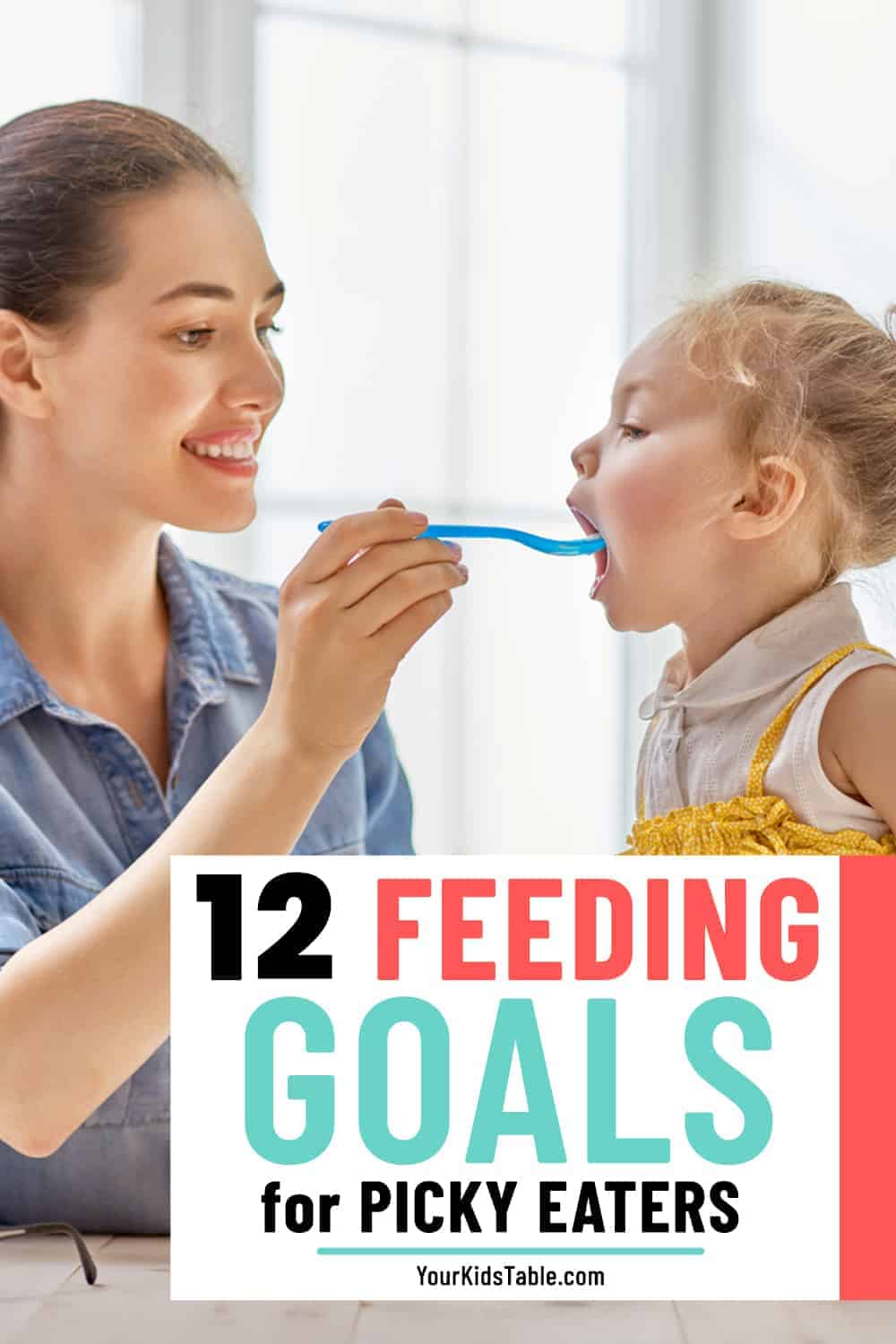Get inspired with the list of feeding goals for picky eaters that’s perfect for OT’s and speech therapists that are providing pediatric feeding therapy!
If you’ve found your way here from a Google search as an occupational therapist (OT) or a speech-language pathologist (SLP) for feeding goals for picky eaters, you’ll find a lot of examples below.
But, this is also a parent-friendly post, because I think, as a parent, it’s incredibly helpful to know and understand either what your child’s feeding therapist is working on or what types of goals you can set in your own home, although perhaps not as formally.
As an occupational therapist of nearly 18 years, I’ve written MANY feeding goals for picky eaters, or kids that were struggling to eat more than few foods.
Do All Picky Eaters Need Feeding Goals??
Picky eating is a BROAD term that encompasses everything from a child that doesn’t like vegetables to a child that gags when he sees any new foods.
Picky eaters that need feeding goals have severely limited diets that are either impacting their growth and height, and/or are causing significant stress in the child or family’s life on a daily basis.
Kids with a developmental delay, autism spectrum disorders, or sensory processing disorder commonly have feeding difficulties. However, lots of kids that are typically developing in every other way can have feeding difficulties.
If you’re a parent and aren’t sure where your child falls on this spectrum, take our picky eating test, to see which category of picky eating your child falls into.
PFD, ARFID, Problem Feeders, and Extreme Picky Eaters
Fortunately, we now have a proper feeding disorder diagnosis for kids that are struggling to eat a variety of food that captures the challenge much better than “picky eating,” which is Pediatric Feeding Disorder (PFD).
In the past, terms such problem feeders and extreme picky eaters were frequently used by therapists to describe these children who had a difficult time eating because of their sensory processing, oral motor skills, or physical conditions.
Those terms are still used for kids that don’t have the diagnosis, but generally have less than 20 foods and have extreme reactions or consistent utter refusal to eat new or different foods.
ARFID, or Avoidant Restrictive Food Intake Disorder, is not a feeding disorder, it is an eating disorder in the same category as anorexia and bulimia. Kids with this diagnosis have irrational anxiety about food such as it not being safe, and DO NOT have underlying medical, oral motor, or sensory challenges that affect eating.
The non-profit Feeding Matters has great visuals explaining the difference between ARFID and PFD.
When to Set Feeding Goals for Picky Eaters
As a therapist, the goals should be set during or after the initial feeding evaluation when a trained therapist has assessed a child’s feeding. In some settings, a different therapist may set the goal than the therapist that will be working on the goals in their therapy session.

Changing Feeding Goals for Picky Eaters
If the treating feeding therapist doesn’t feel that the goal is appropriate, talk to the family about adjusting the goal at the 3 month review.
Likewise, parents should have a say in the goals, and feel they are appropriate for their child too. If the goal is too “easy” or too “hard” parents can and should express these concerns to the feeding therapist that’s working with their child. It’s important goals are realistic.
Most often, a pediatric feeding therapist is an occupational therapist or speech therapist, in some cases, it could be a dietician or even psychologist. Whatever the therapists background is in, they should have specialized and advanced training in helping children with picky eating/feeding difficulties.
How to Create Feeding Goals for Picky Eaters
When a therapist creates a new feeding goal for a picky eater, there are several factors that include:
1. What is important to the parent and/or child?
- Sometimes therapists see a child’s challenge or difficulty and can immediately see all the things they can do to help the child. That’s not a bad thing, but if we move ahead without finding out what the family and child’s priorities are, then we’re missing the point. And, parents are likely to not be invested and carry over treatment at home.
2. What is realistic or obtainable?
- It’s critical the goal that’s set is able to be achieved with intervention, otherwise everyone is frustrated and disappointed when working to reach a goal that is far too hard. New goals can be created as old ones are reached.
3. What is measurable?
- Feeding goals must have a measurable component so therapists are able to assess if a child has been successful or not. The goal should be clearly objective, not subjective.
4. How long will you measure this goal?
- Most feeding goals do well to be over a several month period as intervention strategies take time and consistency. But, this will also depend on the feeding therapy setting and the families circumstances, you may have shorter or lengthen time frames and the amount of trials as part of your goal.
5. Use your clinical knowledge, education, and the results of the assessment to determine how much assistance, if any, a child will need to reach the goal.
- With every one of the above elements in creating your goal, you also want to make sure it aligns with what you saw in the assessment or that you know is backed by evidence and/or your clinical opinion, when that applies. That also includes if they’ll need physical assistance or verbal cues.
For instance, the family may communicate that their greatest desire is for their child to have some more protein sources, but you see that their oral motor skills are weak from the assessment. This will help you tailor the goal to include the specifics of “soft or pureed proteins”.
Examples of Feeding Goals for Picky Eaters in OT or Speech Therapy
Use the above 5 steps as you work to create your feeding goals for picky eaters. They can be adjusted to work for a variety of settings. These feeding goals vary by age, skill level, underlying cause, and time frame:

1. Ava will tolerate (1/2/3) new foods on her plate without throwing the food while eating preferred food during meals in 1/3 trials with (25/50/75%) physical assistance and with (25/50/75%) verbal cues so that she can get used to being near different foods.
2. Logan will touch 2 new foods in 4/5 trials without direct physical or verbal prompting which can be interpreted as pressure, but with 25/50/75% modeling through play and cooking activities so that he can become comfortable with the textures of a wider variety of food.
3. Sam will sit at the table for meals in his (classroom/home/cafeteria) without getting up more than one time in 3/4 trials with (25/50/75%) physical assistance and (25/50/75%) verbal cues so that he can participate in the mealtime experience with his family and eat his food.
4. Leah will chew (soft cooked cubed foods/hard crunchy foods/mixed texture foods) without gagging and safely swallowing in 4/5 trials with (25/50/75%) physical assistance and (25/50/75%) verbal cues so that she can eat a wider variety of foods and increase her nutrition.
5. Chase will close his mouth and swallow pureed foods/stage 1 baby food without spitting it out or gagging in 2/3 trials given (25/50/75%) physical assistance and (25/50/75%) verbal cues so that he can begin to take foods orally and be weaned off his feeding tube.
6. Savannah will feed herself diced foods using a fork in 3/4 trials given (25/50/75%) physical assistance and (25/50/75%) verbal cues so that she can eat independently at meals.
7. James will independently eat 1 new protein as part of his meal in 2/3 trials given 0% physical assistance and 0% verbal cues, as both would be a pressure technique, so that he can expand his variety of foods and get more nutrition.
8. Maddie will sit down and eat the same meal as the rest of the family without yelling when at least one preferred food is provided in 4/5 trials with 0% physical assistance and 25/50/75% verbal cues so that she can learn to tolerate a wider of foods and not only accept specific meals that are different from the rest of the family.
9. Conner will drink 1 oz of milk from a straw cup without coughing in 3/4 trials given 25/50/75% physical assistance and 25/50/75% verbal cues so that he can wean from his bottle and begin to have milk with his meals.
10. Melanie will use her hands to feed herself finger foods in 4/5 trials given (25/50/75%) physical assistance and 25/50/75% verbal cues so that she can feed herself independently and tolerate more textures of food.
11. Jake will voluntarily touch a new food to his mouth in 2/3 trials independently with modeling and without any verbal prompts or physical assistance as this would be pressure, so that he can tolerate the sensory input from the food and eventually be able to eat it.
12. Ella will take 2 small bites of a new food, chew the food completely, and swallow with (15/50/75%) verbal prompts and (25/50/75%) physical assistance so that she can work on managing larger quantities of food as she develops her oral motor skills.
Are you feeling inspired to create your own feeding goals for picky eaters? Let us know in the comments what you came up with and if you have any questions!
What I Mean By “No Pressure” in Feeding Goals for Picky Eaters
I follow the research of Ellyn Satter and my treatment approaches align with Responsive Feeding movement and SOS approach to feeding, which is why you see notations about “not pressuring” in several of the feeding goals for picky eaters.
While traditional feeding therapy behavioral techniques are still used by some, I think OT’s and speech language pathologists that want to use a positive child directed approach for treatment can be tempted to pressure during data collection of these goals.
If I indicated the goal is touching to lips, taking a small bite, or even licking a food, I want to be clear that I’m not sitting across from a child and repeatedly asking them to do that, nor am I rewarding them when they do. Instead, I’m using play with food, cooking, sensory bins, and other strategies to work on them exploring food on their own volition.
Learn more about this picky eating approach.
However, if a child doesn’t have the motor skills to feed themselves, close their lips, or chew, you may need to use physical assistance and verbal cues to help them complete the task they’re working on.
Grab the Feeding Therapy Ideas Printable!
If you’re a therapist that’s working on feeding, grab our special feeding therapy printable: Feeding Therapy Ideas (+Oral Motor Exercises Printable)
If you’re a parent, we have this version of the printable that will be helpful for you too. You can get the parent version here!
More on Feeding Therapy for Picky Eaters
8 Big Feeding Red Flags for Babies and Toddlers
3 Ways to Tell If You Have a Good Feeding Therapist
How to Wean Your Child From Tube Feedings to Eating By Mouth
Self-Feeding: The Complete Guide for Babies and Toddlers
Alisha Grogan is a licensed occupational therapist and founder of Your Kid’s Table. She has over 17 years experience with expertise in sensory processing and feeding development in babies, toddlers, and children. Alisha also has 3 boys of her own at home. Learn more about her here.

Absolutely love these feeding goals—thank you for sharing! I’d just like to gently note that while ARFID is categorized under Feeding and Eating Disorders in the DSM-5-TR, its treatment approach often differs from that of AN, BN, or BED. Interventions like CBT-AR, Exposure Response Prevention, Food Chaining, the Get Permission Approach, and SOS principles are commonly used.
We also recommend using group formats that better meet the unique needs of those with ARFID, such as Food Discovery, Enhanced Exposure, and Body Awareness groups, rather than traditional body image or standard ED process groups.
And we find that multidisciplinary approaches work best– mental health, speech, OT, PT, medical, nutrition.
I think there is a big misunderstanding that ARFID is treated purely with behaviorism or that we treat it like a traditional eating disorder.